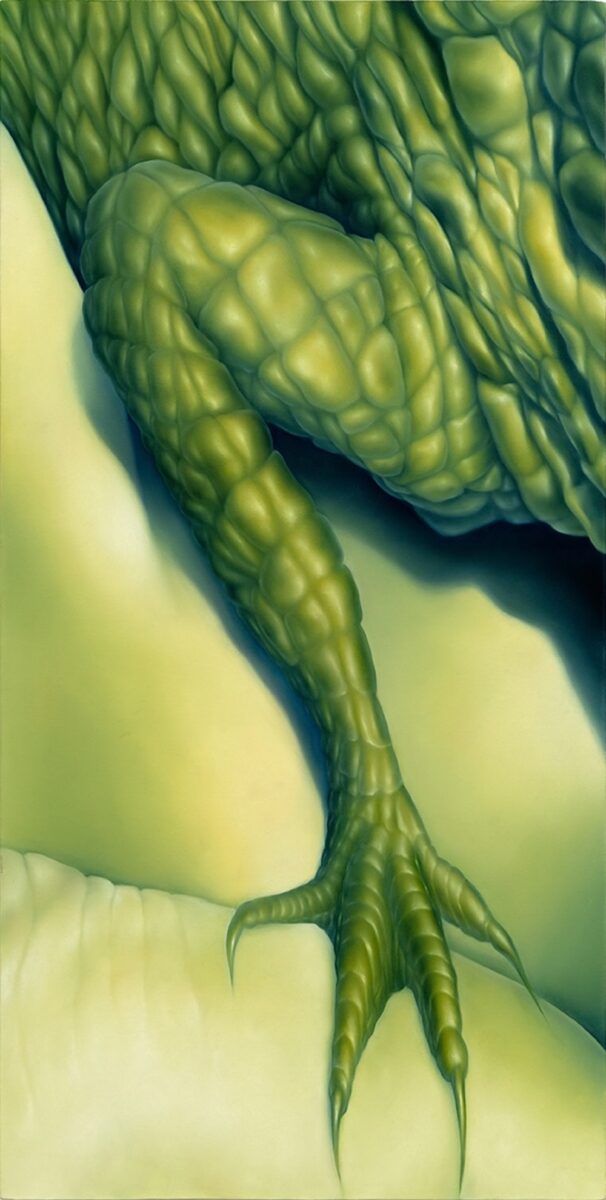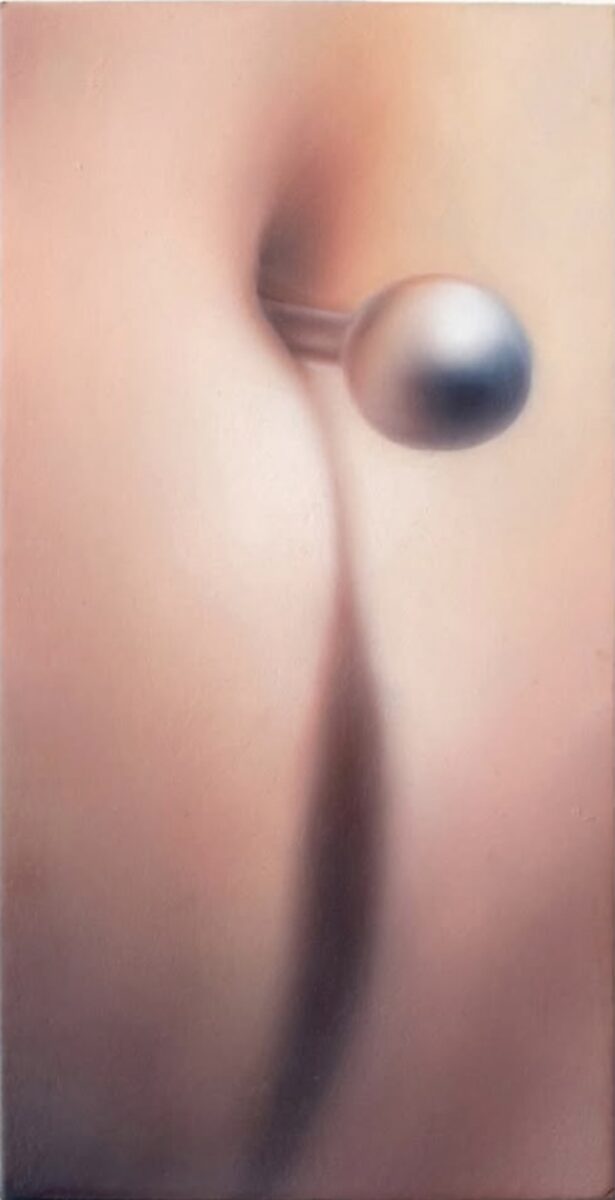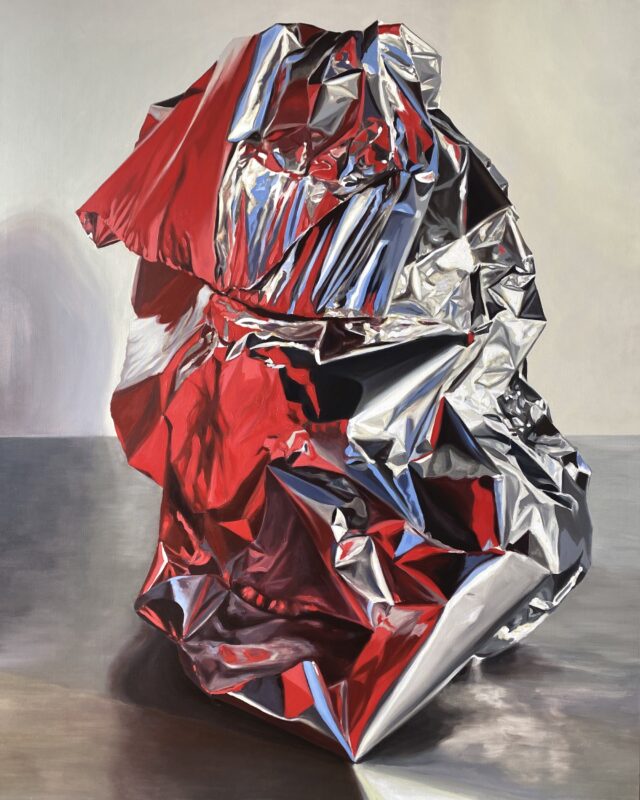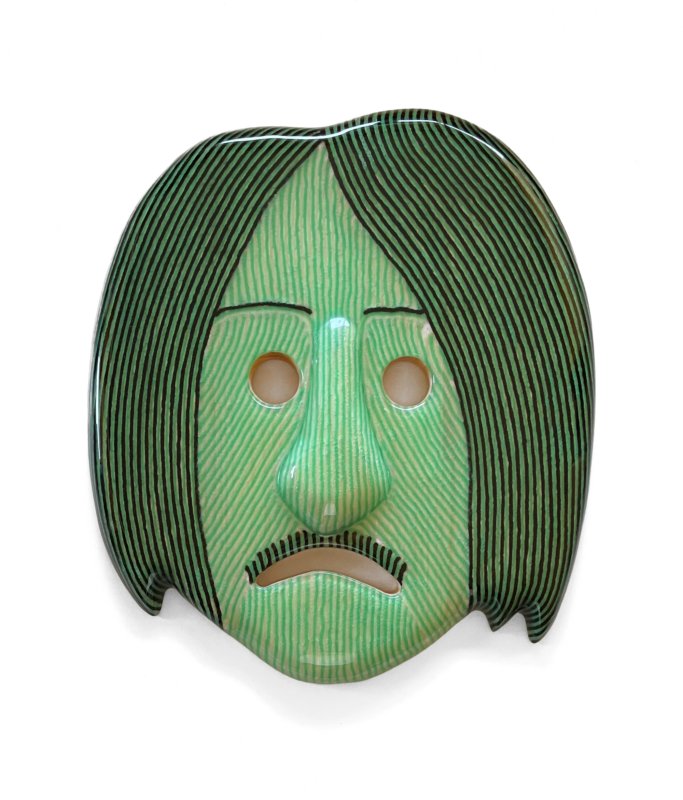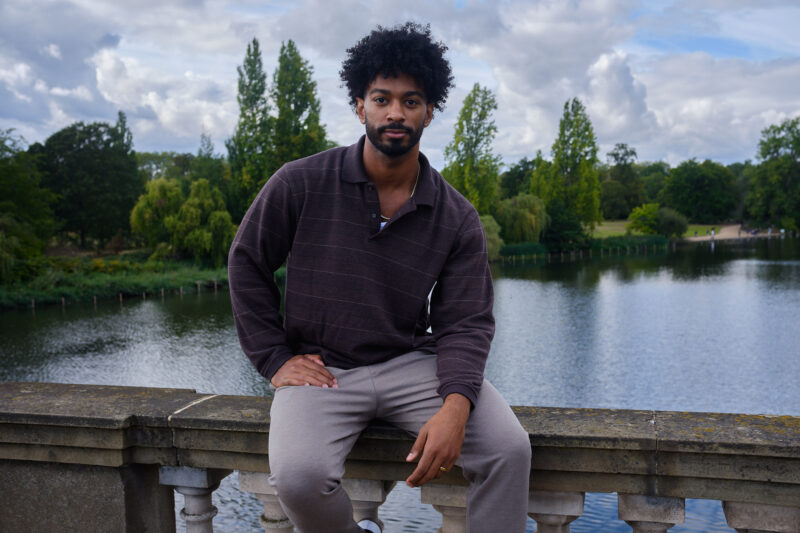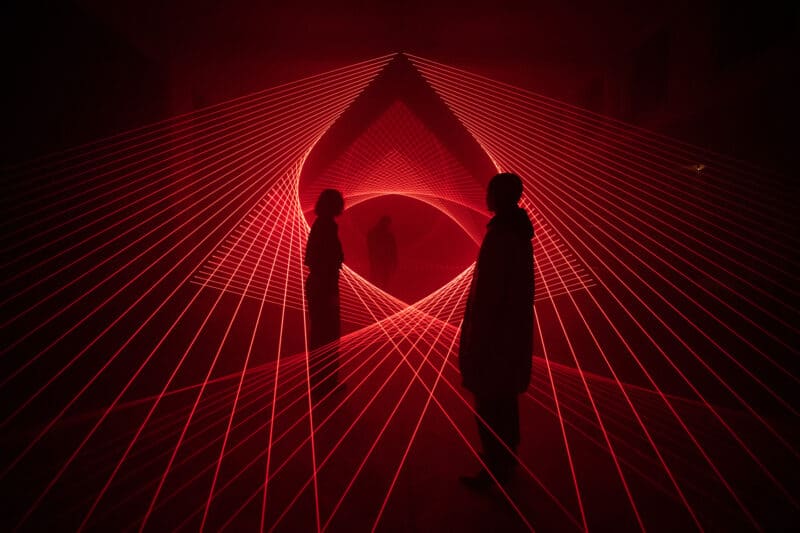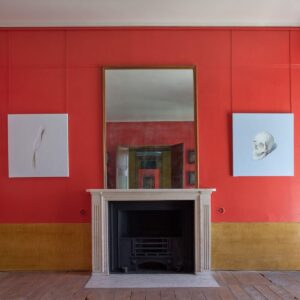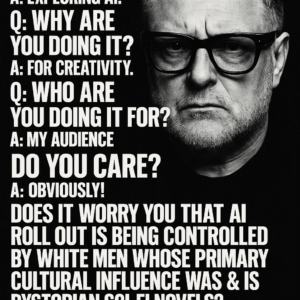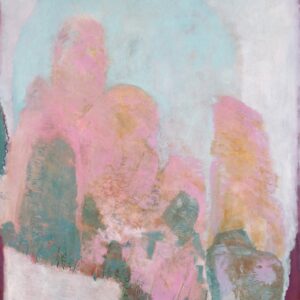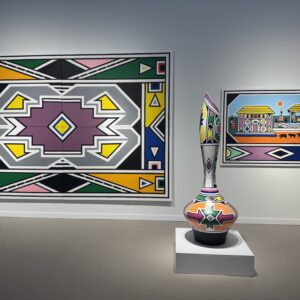
Alejandra Moros is a Miami-based painter whose work explores the intimate, often overlooked moments that shape our understanding of connection, identity, and vulnerability. In her paintings, she zooms in on the minute details of the human body—tiny wrinkles, strands of hair, or the curvature of a finger—transforming these otherwise ordinary features into vast, almost otherworldly landscapes. By focusing on the subtle textures of life, Moros invites viewers to reconsider how we experience and interact with the world around us.
Moros’s practice is built on a foundation of curiosity and transformation. Through her meticulous oil paintings, she creates highly detailed, hyperrealistic images that compel us to look closely at the body and its relationship to both the self and its surrounding objects. Her choice of subject matter can be deeply personal; many of her paintings are based on reference photos of those closest to her. Yet, these figures are abstracted and decontextualized, stripped of their identity and presented as something larger and more symbolic. A simple hand caressing a necklace bead or a few strands of hair brushing against an ear are rendered with such attention to detail that they take on new meaning, becoming metaphors for deeper emotional states and experiences.
Color plays a significant role in Moros’s work, adding another layer of abstraction to her compositions. Using a restrained palette of blues, greens, orange, and white she applies her paint using a smooth, dry-brush technique that produces a soft, almost dreamlike effect. The colors, though artificial and carefully chosen, evoke feelings of intimacy and closeness—suggesting a moment of connection when the boundaries between bodies blur, and the world around us feels at once vivid and intangible. The tactile quality of her paintings reflects how we often experience intimacy—fuzzy, unclear, yet undeniably real in its emotional intensity.
Moros’s work is deeply invested in the idea that the most profound connections can often be found in the smallest, most ordinary interactions. Her close-ups of the body transform the mundane into the extraordinary, revealing the emotional weight embedded in the intimate gestures we share with others. These seemingly simple moments, when rendered with such care and attention, come to embody the complex, layered relationships we have with ourselves and those around us.
Due to the scale and painstaking detail of her work, Moros’s art elicits a powerful emotional response. Her paintings create an immersive experience, drawing the viewer into a space where the boundaries between reality and the imagined are blurred. In this way, her art speaks to the heart of human connection—the desire to understand and be understood, to share in the impermanence and beauty of life’s smallest moments.
Moros earned her BFA in painting from the University of Miami and has exhibited her paintings at numerous galleries, including Spinello Projects, Dale Zine, Flowerbox Projects, and ICA in Miami; PM/AM Gallery in London; GARTEN Gallery in Italy; and Fragment Gallery, Marinaro Gallery, and Harper’s Books in New York.
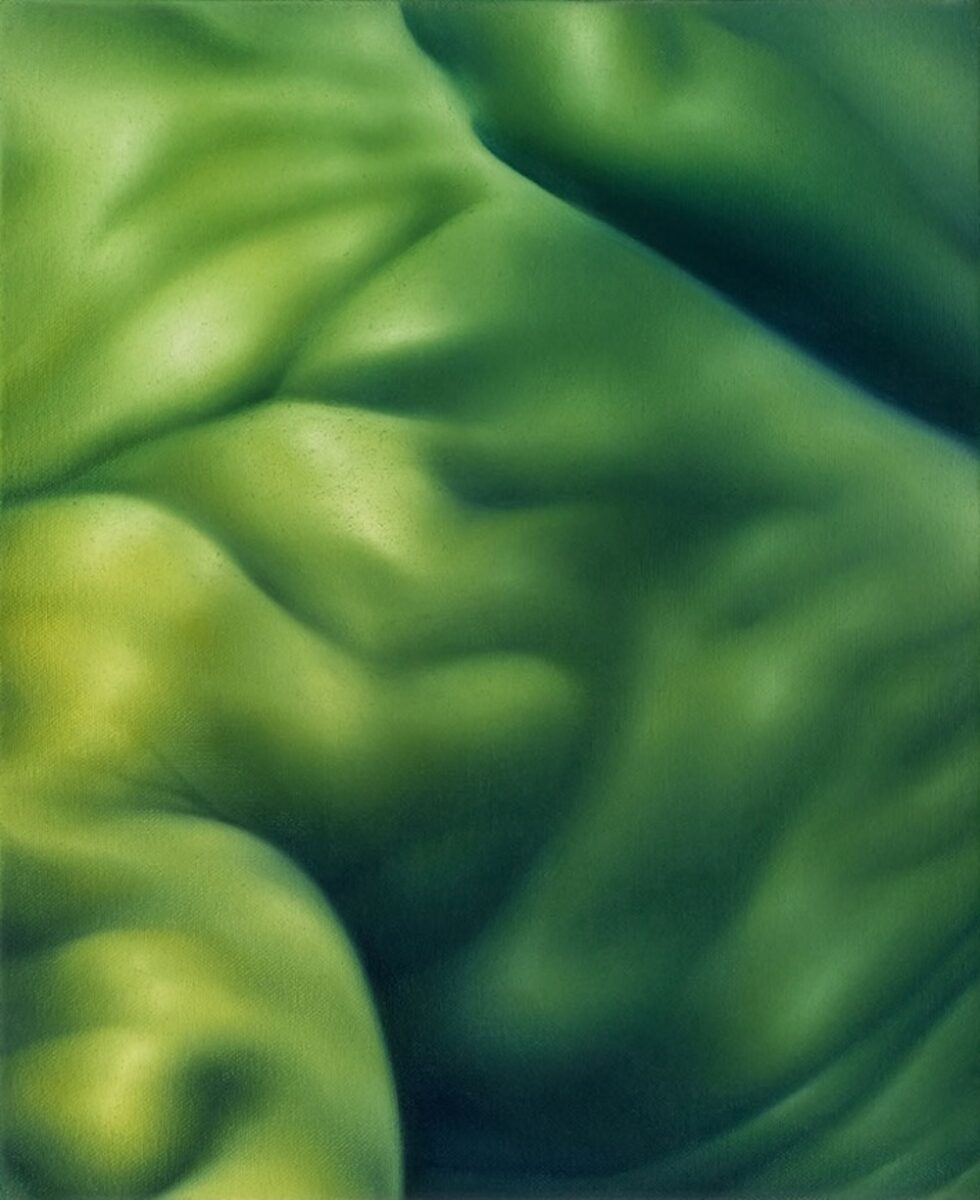
Phillip Edward Spradley: I appreciate the distance and intimacy in your paintings. Your work focuses on the details of surfaces, largely the human body. What draws you to these small, often overlooked moments and details, and how do they reflect broader themes of connection?
Alejandra Moros: When I first started painting I was doing a lot of portraits, but it felt way too precious. Getting closer was a way around that; I never forget who the paintings are of, or where I took the picture, or why I was drawn to it in the first place. I’ve always been drawn to body modification and adornment of any kind, so that will always catch my eye, and I think allowing myself to give in to tunnel vision allows me to paint things that feel hyper specific, allowing it to still feel like a portrait in some ways, while not giving too much away.
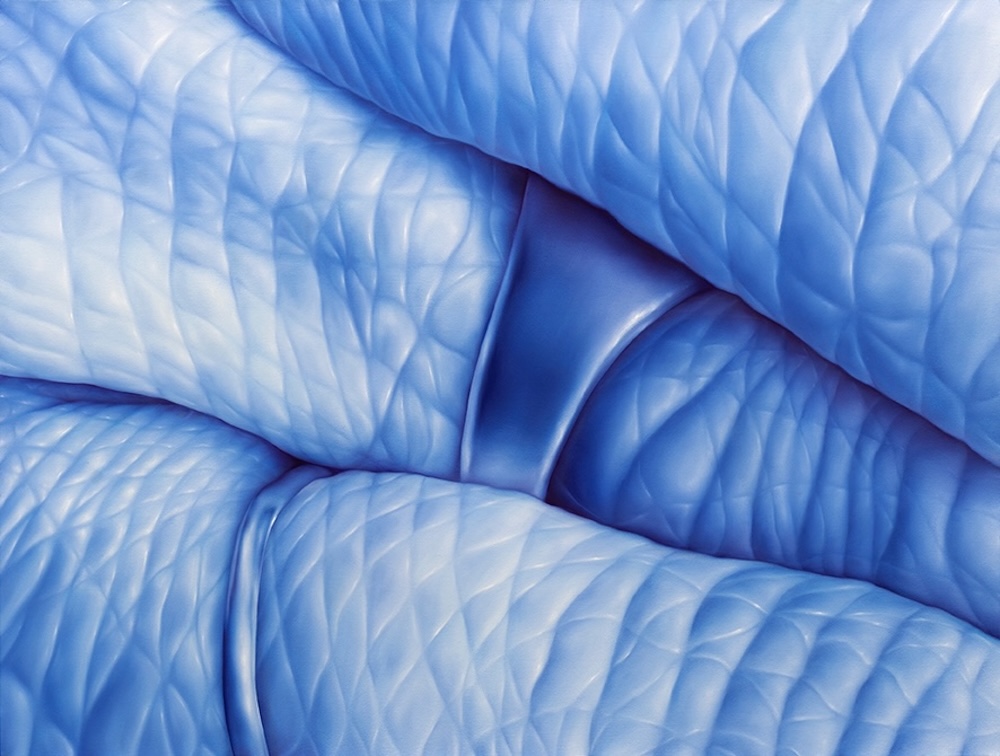
Can you walk me through your process of capturing moments and translating them into a painting? One piece I keep coming back to is Ghost Image. How do you choose which specific details or areas to focus on, and how do you bring those to life on the canvas?
Ghost Image specifically was a moment of oh, I like the rings you have on today, and I took a video of them moving their hands around while we talked. A still from that video later became that painting. Very often it becomes a “This reminds me of …” moment, which makes me so much more obsessed with the image itself because now it has all these connections for me, and it leads to wanting to make that feeling a bit more tangible.
I think that’s why I’ve loved visiting photo archives lately. Physical photo archives will have so many weird nuances, like a photo on the back that leads me to something else, or a misfiling or just what things have been placed next to, which will lead me down a long line of associations that I probably wouldn’t have gotten to otherwise. I still take most of the images I paint, but a few found images will crop up as a link to the next thing every now and then. I think a lot of my work is linear in that way, or ideally at least. One image will always lead me to the next.
You’ve worked from video stills, photo archives, and your own photography in your art. Have your ever recreated moments that passed by too quickly for you to capture? If so, how do you approach the challenge of translating that fleeting experience into a more permanent form through your work?
If I can’t get something as an image I’ll usually write it down later in extreme detail or at least hold on to a phrase. Sometimes those ideas can come back up, or something will remind me of it and I’ll find a way to tie it into another painting, even if just as a title. It won’t be as permanent as a physical representation of it, but all of these paintings have so many associations built into them for me anyway; no still image will ever get all of it. All of them have a built-in “This looks like x which reminds me of y which also looks like z…” that would be impossible to pin down in a way that makes sense to anyone but me.
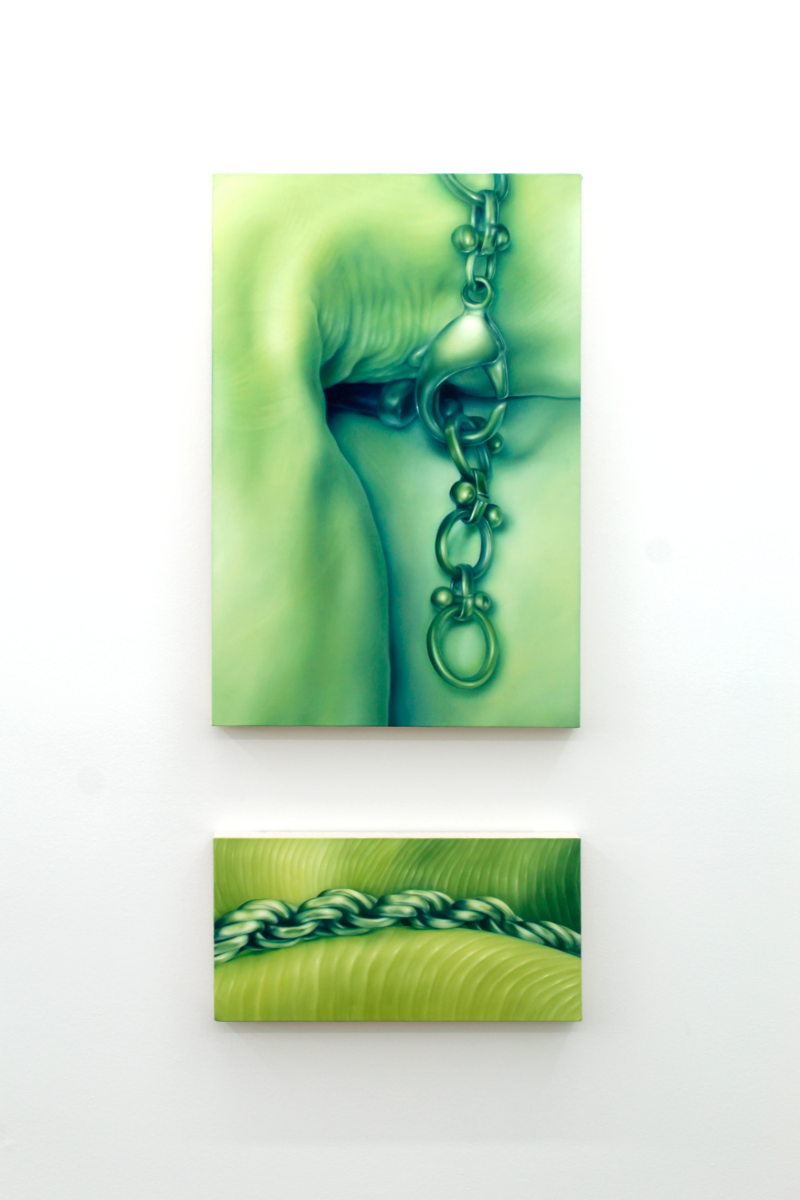
Bottom: Haulover Love Letter, 2023. Oil on canvas. 10 x 20 inches. Courtesy of the artist.
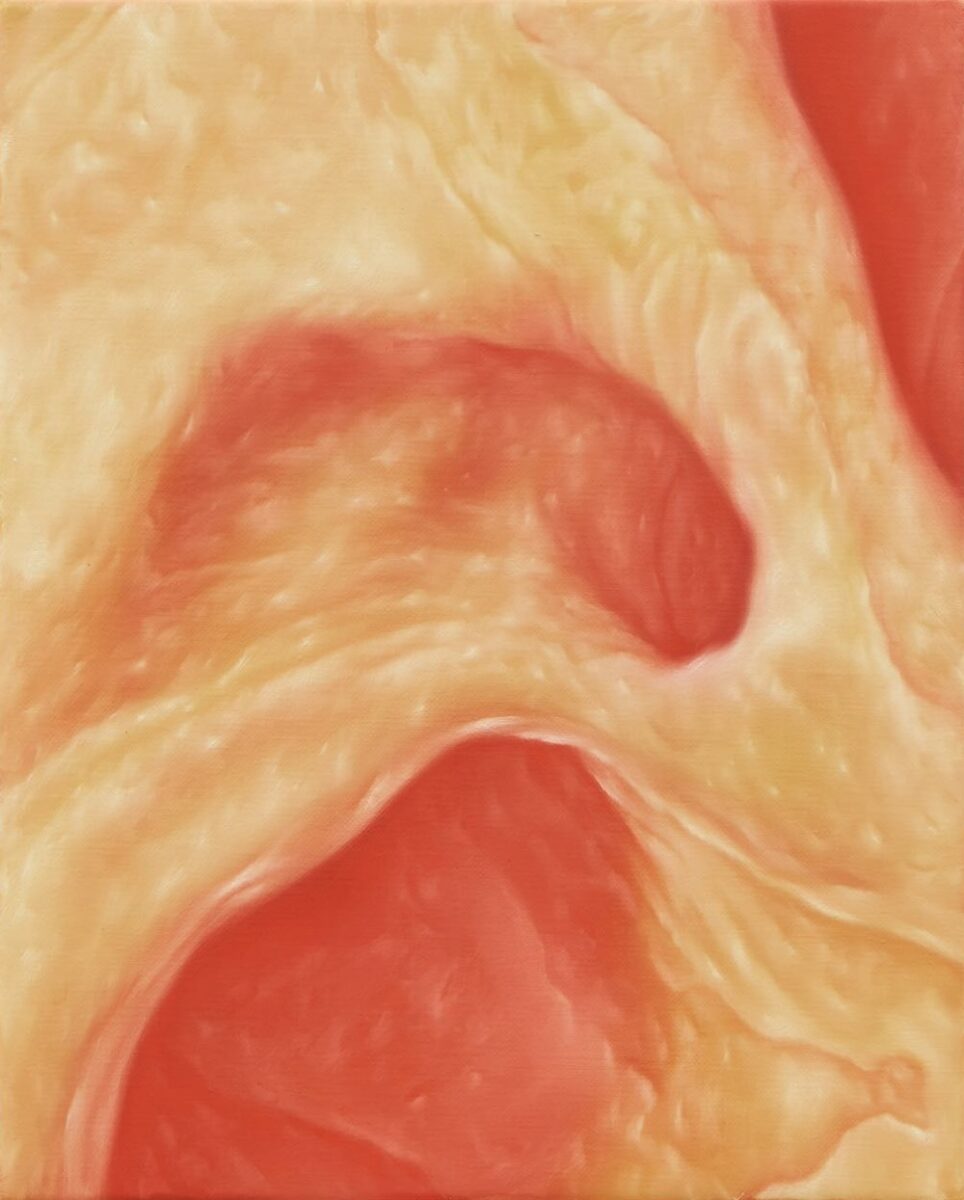
Color plays a significant role in your work, contributing both abstraction and intimacy. You often refrain from depicting figures and objects in their natural colors. Could you share your process for selecting a color palette, and how it influences the emotional tone of each painting?
We talked previously about how I’m obsessive…I think that translates down to materials as well. I have four specific pigments I use, and even though every so often I force myself to reach for something else, I’d say that about 90% of my paintings are done using those four tubes of paint. I think I just fell in love with how some pigments look and feel, and I also love adding one more layer of separation from whatever I’m referencing.
Your technique of using a dry-brush method to create a soft, dreamlike effect is fascinating. Can you discuss why you chose this approach, and how it complements the emotional content of your pieces?
I love how dreamy it can feel…it doesn’t just add another layer of disconnection, but it also makes it feel a little more precious. I think my thought process never really lands squarely on anything, and the fuzziness feels like a reflection of that. It’s also really fun to paint shiny things.
I think on a technical level, it also teaches me so much. With painting it’s an endless learning curve. I love painting the same dot and blending it out over and over again because it feels similarly endless. I can always push it further away from feeling concrete and real.
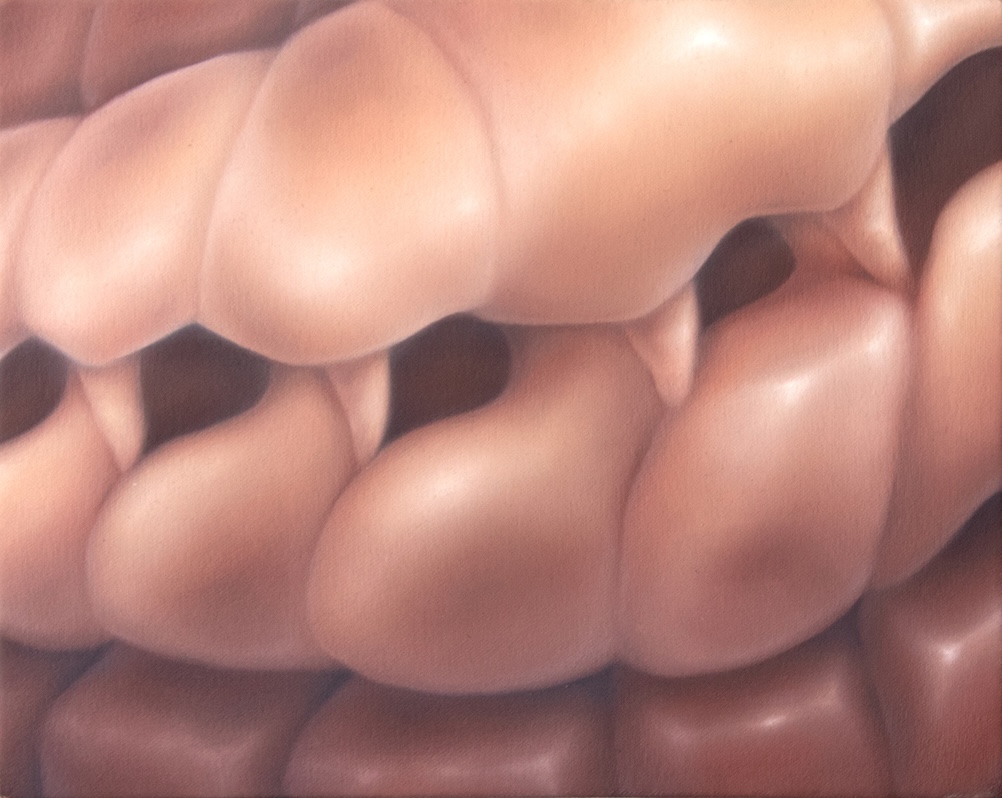
There’s a sense of abstraction in your work, where familiar objects and features are stripped of context. How do you balance the personal nature of your subject matter with the abstract qualities of the final piece?
That’s definitely a way of keeping things precious, as well. I don’t need everyone to know that a painting is of my sister or another loved one, but I get to know that, and that will always keep it feeling really special to me.
There are definitely some that I do get excited about and want to share more about, especially the ones based on found images or the ones that feel so tied to Florida specifically. It’s definitely something I’m still learning to navigate. I could have the painting of my sister next to one of a gator and I’m like, okay, how do I talk more about the latter while not making it a measure of importance? Some things just need to stay precious.
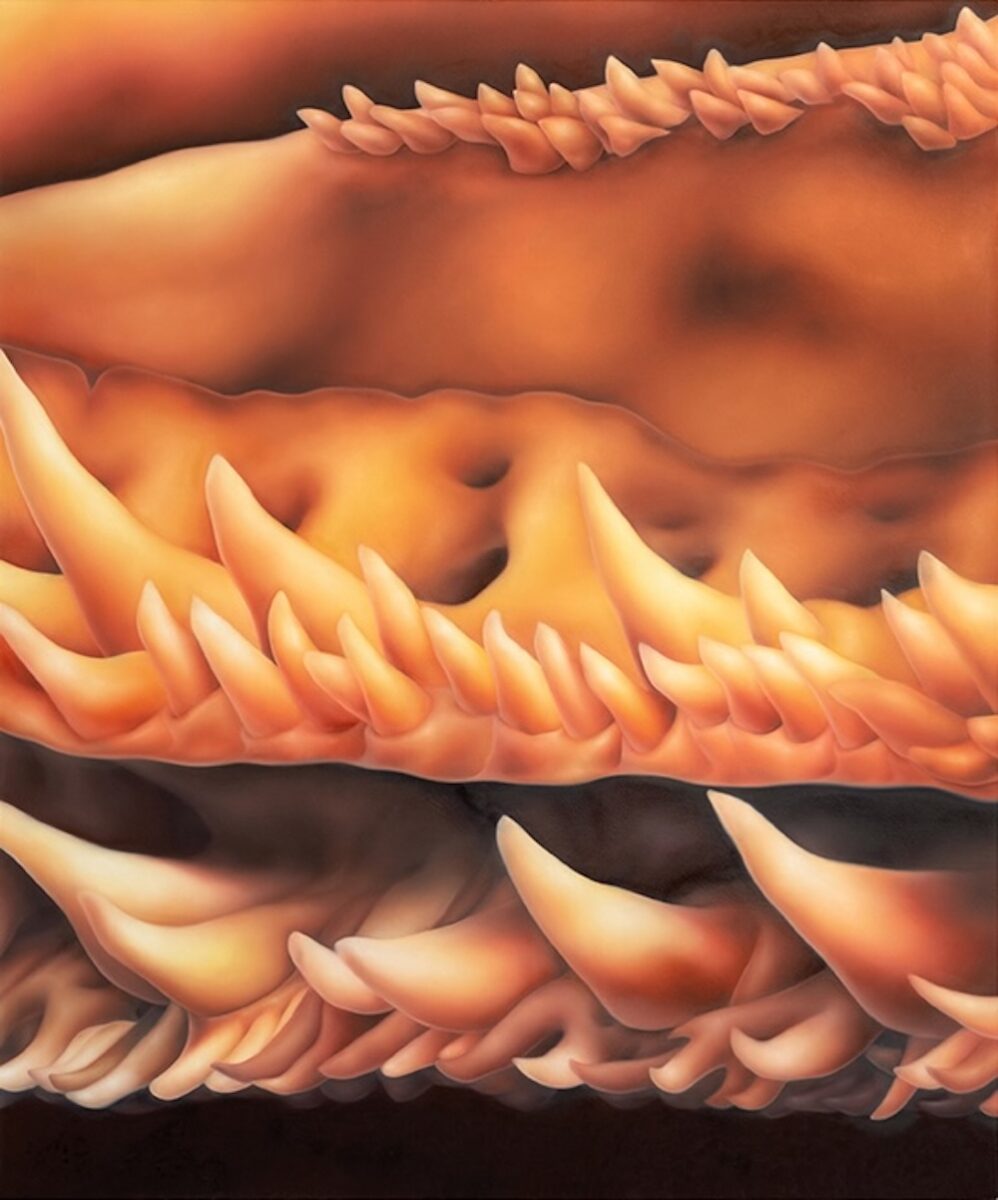
The paintings invite viewers to reconsider how they perceive the body and identity. How do you hope your work impacts the way people view themselves and their relationships with others?
I’ve always been interested in the body as a changing/changeable thing. And then I’ve been thinking a lot recently about adaptation and evolution and the way things change in Florida specifically. It gives me a lot of hope– any changes we want, more drastic transformations, evolutions, revolutions, etc. have occurred. The wildest ways people imagine my images past their borders aren’t that wild, relatively.
The intimacy in your paintings is palpable, yet there’s a sense of mystery in the way you depict your subjects. How do you decide what to reveal and what to keep ambiguous in your work?
A lot of it is intuitive. I also, despite loving the dreaminess of something that feels transitory, want to have something to land on, something people can hold on to. I like my feet on the ground, to be honest. And like I mentioned before, there are some I feel comfortable sharing more of, just like there are some where this is all I can give.
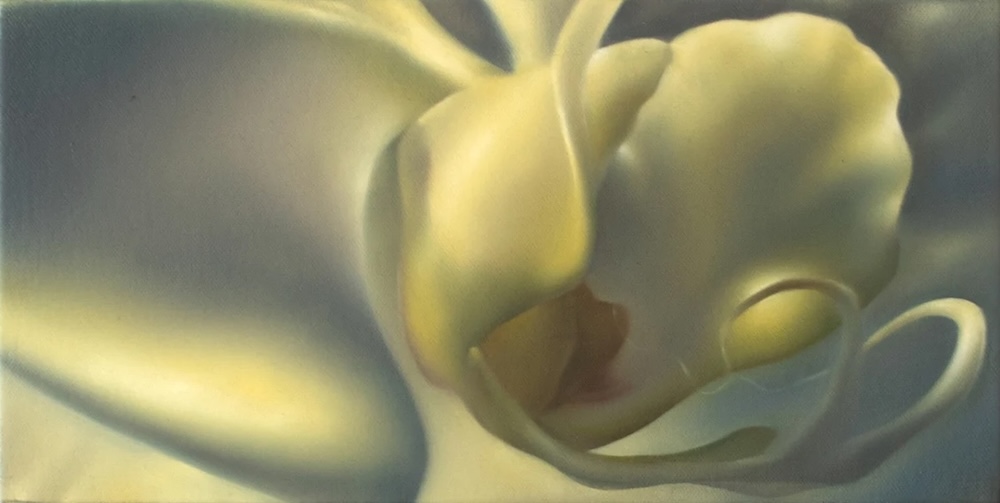
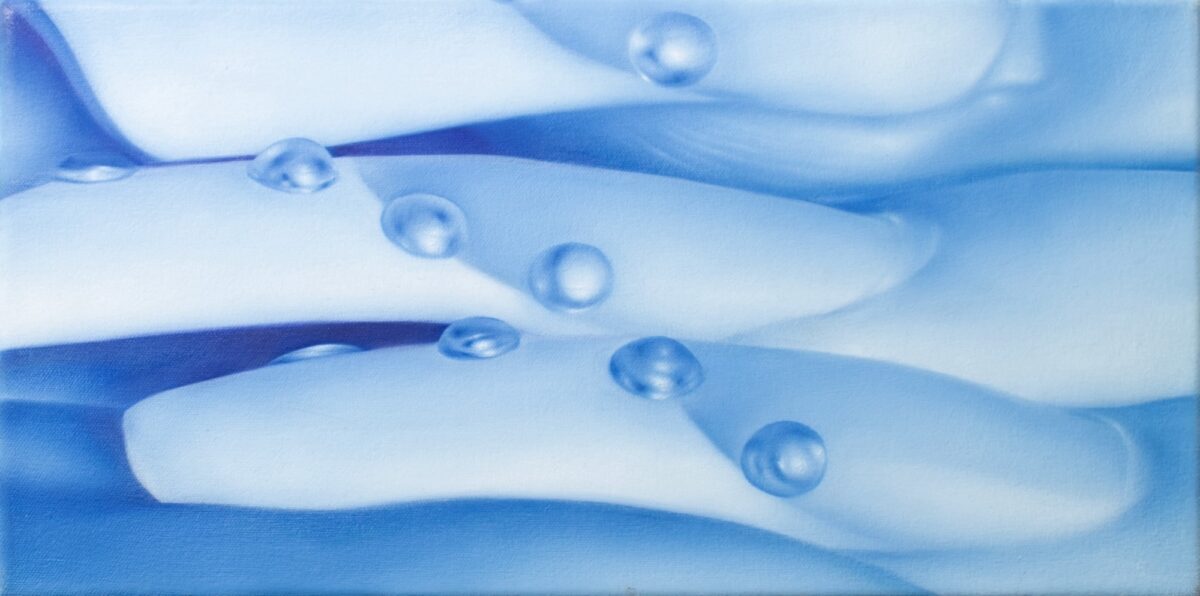
Your work seems to balance both the overwhelming scale of the paintings with the subtlety of the subject matter. What do you hope people take away from the experience of engaging with your large-scale, intimate works?
I don’t know, I like when things feel obsessive and immersive. Part of making anything is being like, okay, once it’s out of my hands, it’s fully out of my hands. I have no control over what people are going to do with it. But when people tell me their own associations, what the paintings feel like, what they remind them of…yeah, keep the line of thinking going, I wouldn’t have gotten to that specific connection. Some people are more poetic about it than I could ever be. It’s always fun to hear.
To learn more about Alejandra Moros, visit her Instagram at @alemoros and her website alejandramoros.com
